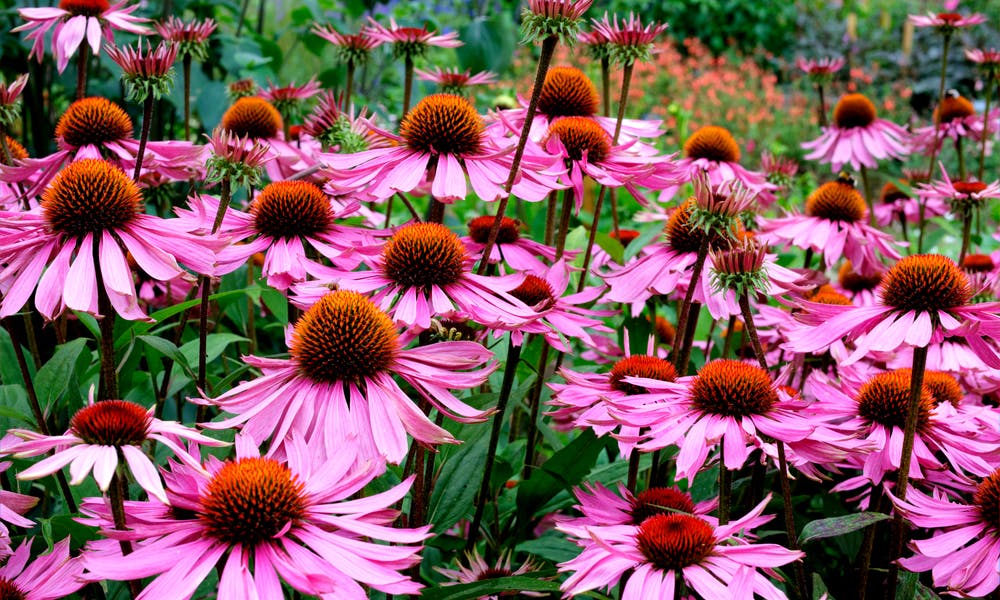MENU
Echinacea: The Therapeutic Beauty

Coneflower, or echinacea, is a fine plant native to North America, with large flowers and blooming for a long time. It is one of the plants that has proven its effectiveness in increasing the body’s defense capacity against various infectious agents. This plant is used in the preparation of tinctures or food supplements, alone or in combination with other plants.
Echinacea flower is part of the same family as arnica, marigold, and chamomile. It is wonderfully colored in orange, red, pink, and yellow. Echinacea flowers are an excellent remedy against many infections, having antibacterial, antifungal and antiviral properties. In this article you find out more about:
* History and origin of the echinacea flower
* What is echinacea flower
* How to grow and take care of echinacea flower
* Therapeutic effects of the echinacea flower
History and Origin of Echinacea Flower
Echinacea, especially echinacea purpurea, is a plant native to North America. In the 19th century, the plant was commonly used for treating snake bites. Echinacea plant is rich in phenols, polysaccharides, and volatile oils; furthermore, it made its presence known in Europe in the 1930s.
Echinacea is naturally found in nine varieties, but only three species are most popular for their therapeutic benefits for several ailments: Echinacea Purpurea, Echinacea Pallida, and Echinacea Angustifolia.
What Is the Echinacea Flower?
Echinacea flower looks like daisies and has long been recognized as one of the most effective natural remedies. It is also highly appreciated for the beauty of its colorful blooms.
Echinacea is a medicinal plant, native from wet and dry prairie areas of North America.
This plant blooms during the summer and can be recognized due to its thin petals in shades of purple, red, or orange and is popularly known as the colored daisy.
How to Grow and Take Care of The Echinacea Flower
Echinacea is a beautiful decorative wild plant at its origins. You can grow it very easily, using seeds or using pieces obtained by dividing the bush. The plant is an ideal choice for a beginner gardener because is not pretentious, and adapts very easily to the weather conditions. Echinacea can harmonize with the other plants from the garden. The plant likes sun, but it can grow very well in semi-shade.
The ornamental plants of the echinacea should be placed in a sunny place and on a clay-sandy soil, rich in humus. During the growing period of two or three months, the plant needs large quantities of water. Shrub splitting is done in early autumn or in March – April, and divided plants should be planted immediately in the garden or pots.
Echinacea is a perennial plant, ideal to be planted outdoors. The sowing should be done from the beginning of the year until May, and the flowering period starts at the end of August. We can find blooming echinacea up to the first frost.
Echinacea flower can grow from 2 to 5 feet tall, and from 1 to 2 feet wide. Due to the large size of the plant, it is advisable to ensure a generous space between the seed nests. After planting the seeds, you should ensure consistent watering so that the seeds sprout faster.
The plant adapts easily to any weather conditions, but in times of drought, it requires more water than usual. The plant has long roots that facilitate water storage capacity but it is not considered a resistant plant.
The rich soil favors the ideal development and the magic blooming of the echinacea flower. It is recommended to use decomposed manure to feed the echinacea plant; as this product takes up to three years, you may also choose to use fertilizer to ensure the ideal conditions for your echinacea flower.
In the first year of vegetation, the plant forms only a rosette full of leaves. The wonderful flowering occurs in the second year of plant life. After the first flowering year, the flowers can be harvested year by year and dried. Drying can be done in specially arranged spaces, naturally, in the shade and placed in a thin layer.
Echinacea attracts many butterflies due to the colorful flowers but also birds that feed on its seeds, so you are bound to have a colorful and lively garden if you choose this flower.
Therapeutic Effects of The Echinacea Plant
Echinacea can be used in the form of tincture, powder, or tea. Echinacea juice can be administered to prevent and cure viral or microbial illnesses. It fights against the cold, influenza, bronchitis, other respiratory tract infections, and many more.
Echinacea plays a key role in supporting the immune system and liver function. Furthermore, it is an effective natural remedy for combating asthma attacks. In this sense, it is used as a tincture. Echinacea tea is a good antibiotic for the urogenital tract, and it is also a very good disinfectant and analgesic for localized pain caused by urinary infections.
You can also treat oral diseases by gargle with the echinacea tincture. As ointment or poultice, echinacea stimulates the healing of abscesses or boils. It is a powerful antiviral agent that fights against the herpes simplex virus.
Used externally, echinacea tea can treat superficial skin lesions and can speed up the healing process of eczema and psoriasis. Sedentary lifestyle or pregnancy are two of the main causes of hemorrhoids. Echinacea extract or infusion of echinacea relieves pain caused by hemorrhoids, by using local compresses. Echinacea increases salivary secretions and helps in the digestion process. Also, diarrhea and enteritis can be treated with the help of the echinacea plant.
The products that are based on echinacea are not recommended for diabetics or other people with severe chronic conditions, and in progressive systemic diseases such as tuberculosis, leukosis, multiple sclerosis, AIDS, these products should be used with caution and only at the doctor’s recommendation.
All in all, the echinacea flower is not only beautiful but also a true nature’s gift that helps us heal many conditions and alleviate pain.

